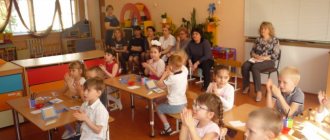PROJECT “SPEECH THERAPY GAMES”
I. _ stage
- prephonemic
II . stage
– phonemic
Prephonemic stage
At the 3rd week, the newborn begins to react to the voice.
By 4 months, reaction to the voice and intonation of spoken speech.
By 5 months, the child grasps the general rhythmic, melodic structure of the word.
At 9-10 months - a reaction to the intonation and meaning of some words. From this time on, the self-learning mechanism begins to work.
From the age of 11 months, the child distinguishes contrasting sounding words ba-ba, pa-pa, ma-ma.
From 11-12 months, phonemic hearing begins to develop. At this time, phonemic hearing allows:
understand the speech of others;
imitate others;
establish a connection between words and objects.
Phonemic stage
By the age of 2, the child differentiates all speech sounds only by ear, and understands well the speech of an adult addressed to him.
By the age of 5-6 years, children already differentiate all sounds both by ear and in pronunciation.
Research by N.H. Shvachkin is confirmed by literary sources and other authors (M.I. Lisina, E.O. Smirnova, V.V. Vetrova, etc.)
In parallel with phonemic hearing, which carries out the operations of discrimination and recognition of phonemes, phonetic hearing also develops, which carries out “monitoring of a continuous stream of syllables.” Phonemic and phonetic hearing together make up speech hearing,
which carries out not only the reception and assessment of other people's speech, but also control over one's own speech. Speech hearing is the most important stimulus for the formation of normalized pronunciation, which can only be carried out with coordinated work between the mechanisms of auditory control and reception on the one hand and control of speech movements on the other.
The functional unity of speech perception and speech production is mentioned in the works of N.I. Zhinkin, N.Kh. Shvachkina, V.I. Beltyukova, A.A. Leontyeva and others.
Even during the birth of phonological theory, the largest linguist Baudouin de Courtenay pointed out that the structure of a phoneme is determined by both acoustic and motor components.
Investigating the patterns of development of children's speech, A.N. Gvozdev notes that the general course of a child’s assimilation of the sound side of speech is determined by the joint action of the auditory and motor spheres: “The auditory sphere is leading in the sense that thanks to the early development of hearing, the child learns to distinguish various phonetic elements by ear; their exact auditory representations become a regulator for their development in his own pronunciation. But for their appearance in the child’s own speech, in addition to auditory ideas, articulatory skills are also needed... These skills are developed later, and with their development, sound elements freely enter into the child’s own speech. From this side, the development of the motor sphere turns out to be decisive for the entire course of mastering the phonetic aspect of the native language. A.N. Gvozdev “A child’s acquisition of the sound side of the Russian language,” Moscow 1948)
Senior group. Senior preschool age. Children 5-6 years old
Summary of the game on "Geocaching" in the senior speech therapy group "Travel to the country of Zdoroveykino" Summary of the game on "Geocaching" in the senior speech therapy group . Topic: “Travel to the country of Zdoroveykino!” Goal: to form in children an idea of a healthy lifestyle; strengthen the basic components of health, create a desire to engage in physical activity. The assignments help...
Summary of an integrated lesson using a laptop in the senior speech therapy group “The beautiful spring is coming”
Goal: to consolidate, expand and generalize children’s knowledge about the season – spring. Objectives: -summarize and systematize children’s knowledge about the season - spring; - develop the ability to compare different periods of spring; — consolidate children’s knowledge about seasonal changes in living and inanimate nature; -...



